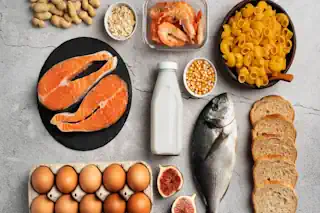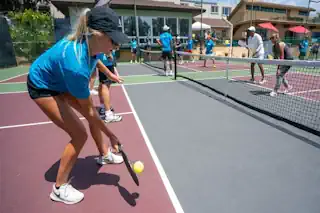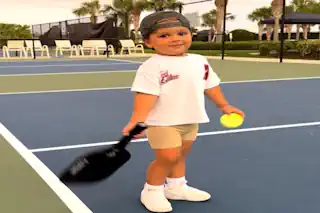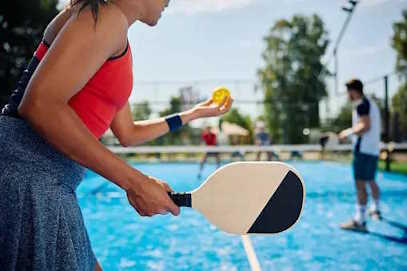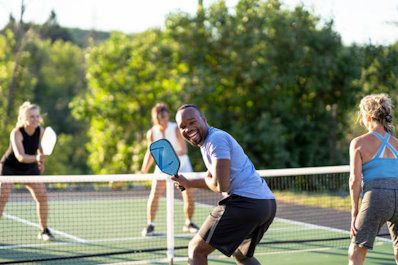The Ultimate Beginner’s Guide to Playing Pickleball
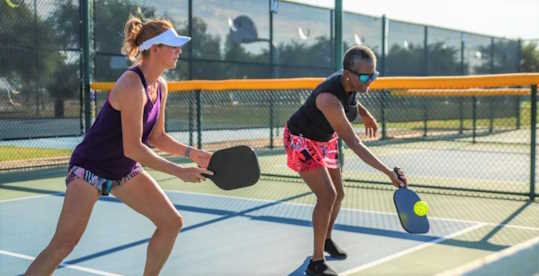
Have you found yourself intrigued by the sound of paddles popping on the court and the small, distinct bounces that seem to sing “pickleball”? This relatively new sport has seen a meteoric rise in interest, all thanks to the blend of its unique rules from familiar games like tennis and badminton, making it easy to get started but tough to master. If you’re ready to take a swing at the game of pickleball, you’ve come to the right place!
From the fundamentals of the game to creating an advanced pickleball strategy, we’ll take you through the ins and outs of this exciting sport. Whether you’re an active senior looking for a fun way to stay in shape, a family seeking an inclusive activity, or an all-out athlete intrigued by the competitive edge of pickleball, this guide is for you. It’s time to pick your paddle up and pickle on!
Getting Started with Pickleball
The Pickleball Equipment Breakdown
Before you can get out onto the court, you need to gear up. Here’s what you need:
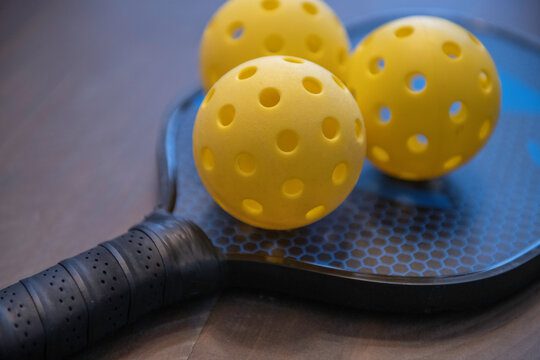
Paddle and Wiffle Balls
The Paddle: Unlike other paddle sports, pickleball paddle head is solid with no strings, resembling a more rounded table-tennis paddle. Choose one that feels comfortable in your hand and suits your playing style.
The Ball: Pickleballs are unique, featuring holes, like a Wiffle ball, for aerodynamics. Opt for a ball that’s approved by the USAPA (USA Pickleball Association) for regulation play.
Pickleball Courts: Similar to badminton, the court has a similar layout but smaller than a traditional tennis court.
The Pickleball Net: A net with specific height requirements separates the two sides of the court.
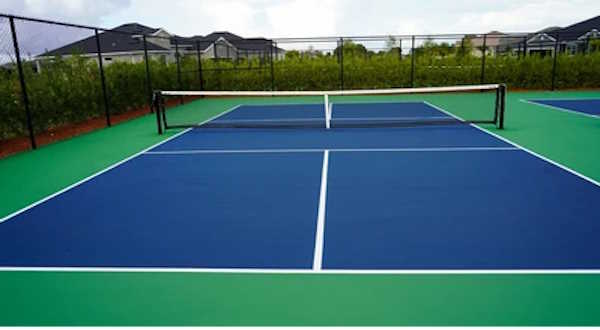
Pickleball Court
Setting Up the Pickleball Court
Here’s a quick rundown:
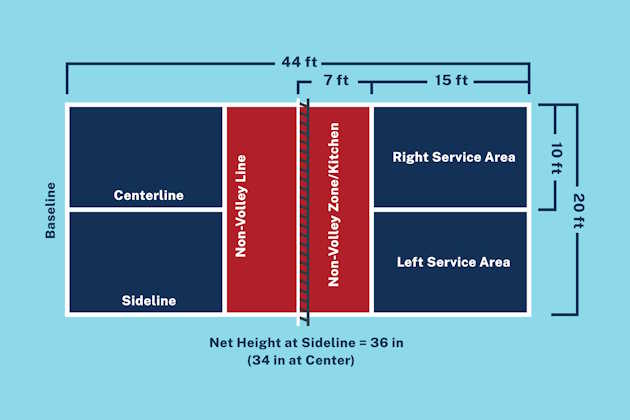
The court is 20 feet wide by 44 feet long.
The non-volley zone, dubbed “the kitchen,” is a critical area for net play.
Determine who’ll serve and which side the first serve will originate.
Pickleball Rules – The Basics
Now that you’re all set with the right equipment and a court to play on, it’s time to dip our toes into the basics of the pickleball rules, which are as easy to grasp as your new paddle. To start, pickleball can be played as singles or doubles, similar to tennis, but with a few unique twists that make it its own beast.
First off, the serve must be underhand, striking the ball below the waist level and the server’s paddle must pass below their knee. The ball is served diagonally across the court to the opposite service box. And here’s a quirky rule that adds to the fun – the serving side keeps serving until they commit a fault. This gives you a fantastic chance to rack up some points!
The ball must bounce once on each side before volleys are allowed; this is affectionately known as the “two-bounce rule.” It makes those first few exchanges a bit more strategic, encouraging a thoughtful approach over brute force. Now, remember the “kitchen” or the non-volley zone I mentioned earlier? Players cannot volley (hit the ball in the air) from within this 7-foot zone on either side of the net. This rule prevents players from dominating the net and keeps the game fair and exciting.
Scoring in pickleball might seem a bit peculiar at first, but it’s as simple as pie once you get the hang of it. The game is usually played to 11 points and you must win by 2 points. Only the serving team can score points, so each serve has that extra bit of pressure and opportunity. The two bounce rule requires the ball to be hit before it bounces twice. A double ball bounce means the rally is over and the serve moves to the next pickleball player.
And there you have it – the basic rules that make pickleball such a uniquely enjoyable game. It’s this beautiful blend of simplicity and depth that’s made it a favorite for so many. Remember, the most important rule is to have fun and enjoy the game. Whether you’re playing a friendly match with loved ones or aiming to conquer the court in a more competitive setting, pickleball offers something for everyone.
Mastering the Pickleball Game
Once you’re kitted out and the court is set, it’s time to familiarize yourself with some basic gameplay rules.
The Serve: Get the Ball Rolling
The serve is critical: it dictates where the game starts. Keep it simple at first, aiming to land your serve diagonally over the net and into the service box. As your skill grows utilize the drop serve or serve deep to keep your opponent on their toes.
Scoring: It’s Simpler Than It Seems
Pickleball scoring can be a bit odd for beginners. But once you understand it, it’s a breeze.
Games go to 11 points, but the winner has to win by 2.
Points can only be scored by the serving side.
The first team to reach 11 points with a lead of at least two points wins the game, though many people play to 15 or 21.
Singles vs. Doubles: It’s a Different Ball Game
In pickleball, the strategies for singles and doubles can vary vastly. You’ll need to adjust your playstyle accordingly.
Strategies for Singles Pickleball

When you’re playing singles in pickleball, the game becomes a test of not just skill but also endurance and strategy. While it feels like just you against the world, here are some bullet points to keep in your back pocket to not just survive but thrive on the court:
Focus on Your Serve: A strong serve can set the tone for the entire point. Aim for depth and accuracy to push your opponent back and give yourself time to position ideally for the return.
Manage Your Stamina: Singles play is more physically demanding. Pace yourself, and choose your moments to exert maximum effort wisely. It’s not just about chasing every ball; it’s about playing smart.
Play the Angles: Use angled shots to your advantage. Creating wide angles can force your opponent to cover more ground, leading to opportunities for you to take control of the rally.
Keep Your Opponent Moving: Try to move your opponent around the court as much as possible. Changing the ball’s direction and varying the depth of your shots can keep them guessing and, ultimately, lead to mistakes.
Stay Positive and Adapt: Maintain a positive mindset throughout the match. Each point is a new opportunity. Adapt your strategy based on what’s working and what’s not against your current opponent.
Utilize the Drop Shot: The drop shot can be a powerful tool in singles. It brings your opponent to the net on your terms, allowing you to drive the next shot past them as they struggle to reset. The drop shot is a powerful play for most pickleball players.
Remember, at the end of the day, pickleball singles is about having fun and enjoying the game. Stay true to your style, learn from each match, and keep these strategies in mind to enhance your single play game.
Strategies for Doubles Pickleball
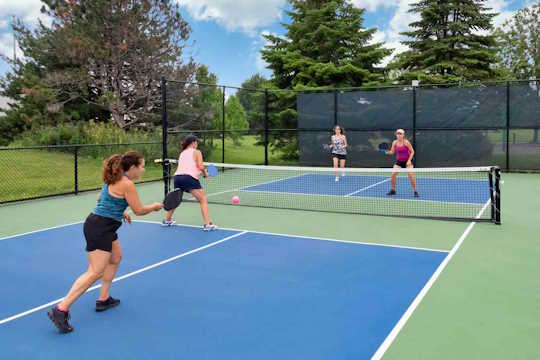
Playing doubles in pickleball brings its own unique set of challenges and strategies. It’s all about teamwork, communication, and understanding the strengths and weaknesses of both you and your partner. Here are some key strategies to help you dominate the doubles court:
Communication is Key: Before anything else, make sure you and your partner are on the same wavelength. Call out shots, communicate who’s taking the ball, and encourage each other throughout the game.
Serve with Purpose: Your serve sets up the point; make it count. Aim for spots that challenge the receiving team and give you an advantage right from the start. Serve deep with an aggressive shot to limit the options of the returning team.
Master the Kitchen: The non-volley zone, or “the kitchen,” is critical in doubles. Control the opponent’s kitchen, and you’ll control the game. Work with your partner to dominate this zone, minimizing opportunities for your opponents.
Develop a Strong Net Presence: Being aggressive at the net can put pressure on your opponents. Work on quick volleys and putaways, but remember, it’s all about balance; don’t overcommit and leave your half of the court exposed.
Synchronize Movements: Good doubles teams move as one. Practice moving together, covering each other’s weaknesses, and capitalizing on your combined strengths.
Strategic Shot Selection: It’s not just about power; it’s about placing your shots where your opponents aren’t. Use lobs, dinks, and drives to create openings and put pressure on your opponents.
Be Adaptable: Every game is different. Be ready to change your strategy based on the flow of the match and the style of your opponents. Flexibility can be your best asset.
Remember, the heart of doubles pickleball is teamwork. Play to your strengths, support your partner through thick and thin, and always keep the game’s joy at the forefront. With these strategies in mind, you’re well on your way to becoming a formidable force on the doubles court.
Improving Skills
Competitive sports are all about skill improvement, and pickleball is no different. Here are some tips to take your game up a notch.
Footwork and Positioning
Footwork in pickleball is about being light and quick—ready to respond to your opponents’ shots at a moment’s notice. Practice positioning yourself to return a shot effectively and maintain court control.
Dinking and Volleys: The Art of the Short Game
Mastering the dink shot is crucial for close-to-net duels. It’s a soft, deliberate shot designed to keep your opponents uncomfortable and off-balance. Volleys are shots that are hit before the ball bounces.
Advanced Shots: Lobs and Smashes
Learn to loft the ball over your opponents with a lob shot. It’s a lifesaver when you’re caught at the back of the court. Conversely, a smash is a powerful overhead shot aimed for speed and placement.
Staying Safe and Healthy
No sport is worth playing if it puts your health at risk. Here are some safety tips for the pickleball court.
Warm-up Exercises
Prepare your body for the match with a thorough warm-up routine. Focus on stretching and light cardio to warm up your muscles and get your heart rate up.
Injury Prevention
Start slow, focusing on finesse over power. Injuries occur most often when players are over-extended, both in their physical limits and their reach for a shot.
Hydration and Rest
Stay hydrated on the court, and don’t forget the importance of rest in your training and playing schedule.
Conclusion
Pickleball is a game for all ages and skill levels. It’s not just about the competition—it’s about community and the conversations you’ll start with every “pickle” that bounces. Continue to learn and improve, and you’ll find yourself not just playing pickleball but loving it.
Join a local club, get some practice in, and most importantly, have fun! You’re now equipped with the knowledge to get started, so go on and pickle to your heart’s content. Remember, in pickleball, every day is a great day to play.
Frequently Asked Questions (FAQs)
Q: Can pickleball be played both indoors and outdoors?
A: Absolutely! Pickleball is a versatile sport that can be played in both indoor and outdoor settings. Outdoor courts are great for enjoying the sunshine and fresh air, while indoor courts are perfect for those days when the weather isn’t on your side.
Q: Is pickleball suitable for all ages?
A: Yes, pickleball is a fantastic sport for players of all ages. It’s a fun way to stay active for younger players and provides a less strenuous option for older players to continue enjoying competitive sports.
Q: Do I need any special equipment to start playing?
A: To get started, all you really need is a pickleball paddle, a few pickleballs, and access to a court. There’s a variety of equipment available for all levels of play, from beginners to seasoned pros, but don’t worry about getting the fanciest gear right out of the gate. Comfortable sports clothing and sneakers are recommended.
Q: How can I find local pickleball clubs or players?
A: A great way to find local clubs or players is through social media groups, community center boards, or dedicated pickleball websites and apps. These resources are wonderful for connecting with fellow enthusiasts and finding out about local events and meetup times.
Q: What’s the best way to improve my game quickly?
A: Regular practice, of course! Additionally, playing with opponents of various skill levels, focusing on your weak spots, and perhaps even taking a lesson or two from a seasoned player or coach can really help speed up your progress.
Can children play pickleball?
Yes, indeed! Pickleball is a fantastic sport for children, as it helps them develop physical coordination, teamwork, and sportsmanship in a fun, low-stress environment. It’s also a great activity for families to play together, making for some memorable quality time.
Q: How important is sportsmanship in pickleball?
A: Sportsmanship is fundamental in pickleball. Respect for opponents, partners, and officials, along with a positive attitude on and off the court, makes the game enjoyable for everyone involved. After all, the heart of pickleball isn’t just playing a good game—it’s about fostering a community and building lasting friendships.
Remember, the most important thing is to enjoy yourself and have fun with it. Everyone starts somewhere, and the pickleball community is known for being incredibly welcoming and supportive. Welcome to the pickleball family!
We’re here for you every step of your pickleball journey. Thanks for being a part of this wonderful community, and don’t hesitate to reach out if you have more questions. Now, go hit some lobs, and most importantly,
